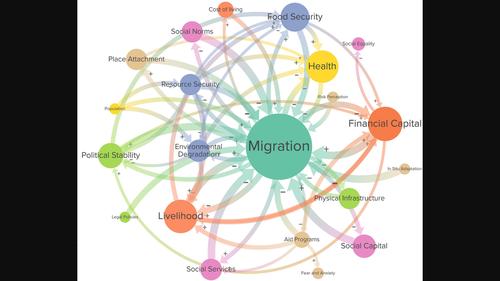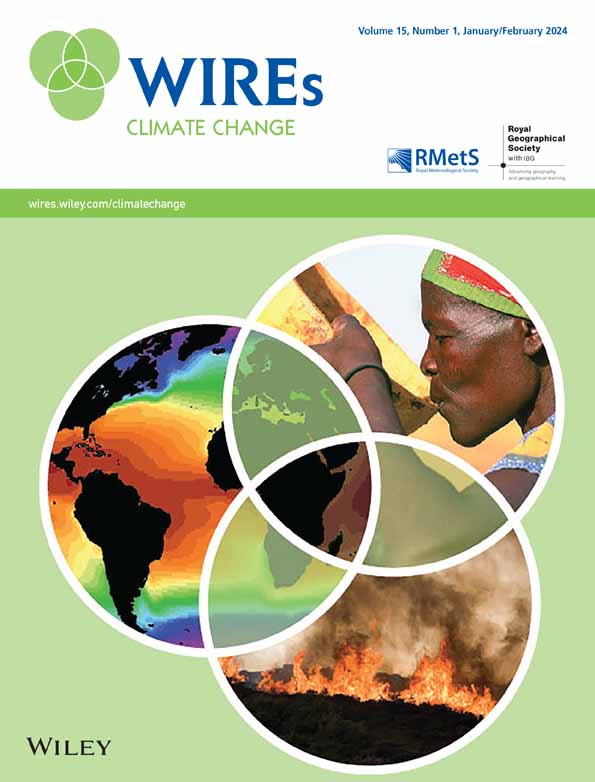影响气候迁移的决策因素相互作用:基于系统的系统综述
IF 10.3
1区 环境科学与生态学
Q1 ENVIRONMENTAL STUDIES
引用次数: 7
摘要
由于气候变化,预计未来几十年全球移民和流动动态将发生变化。然而,在何种程度上移民是由气候灾害引起的,与其他干预因素形成对比或增加,是文献中的一个争论点。在本研究中,我们进行了系统的文献综述,以识别和整合直接和间接影响气候变化移民的因素。在文献综述中,我们发现了21个影响气候移民的经济、环境、人口、政治、社会和个人干预决策因素。这些因素之间的因果相互作用被确定使用轴定性编码技术称为目的文本分析。通过结合因果关系,创建了一个半定量的因果循环图,表示“气候迁移系统”内的因素相互作用和反馈。使用该模型,我们强调了有影响力的反馈回路,并指出干预策略如何引起下游效应。这项研究有助于更好地理解气候迁移中复杂的决策动态。特别是,因果反馈回路的结果表明,针对金融资本、生计以及粮食安全等经济因素的干预策略,将对帮助受气候影响的社区产生最大的影响。这些结果有助于为气候移民政策提供信息,并帮助未来的规划者更好地了解导致气候移民紧急结果的相互关联的因素系统。本文章由计算机程序翻译,如有差异,请以英文原文为准。

Decision‐making factor interactions influencing climate migration: A systems‐based systematic review
Global migration and mobility dynamics are expected to shift in the coming decades as a result of climate change. However, the extent to which migration is caused by climate hazards, in contrast or addition to other intervening factors, is a point of debate in literature. In this study, we conducted a systematic literature review to identify and consolidate factors which directly and indirectly influence climate change migration. In our review of the literature, we found a total of 21 economic, environmental, demographic, political, social, and personal intervening decision‐making factors which affect climate migration. Causal interactions between these factors were identified using an axial qualitative coding technique called purposive text analysis. By combining causal links, a semi‐quantitative causal loop diagram was created that represented factor interaction and feedback within the “climate migration system.” Using this model, we highlight influential feedback loops and point to how intervention strategies may cause downstream effects. This research helps to address calls for a better understanding of the complex decision‐making dynamics in climate migration. In particular, results from our causal feedback loops show that intervention strategies targeted toward economic factors such as financial capital and livelihoods, as well as food security, would have the greatest impact in assisting climate‐affected communities. These results help inform climate migration policy and aid planners in the future to better understand the interconnected system of factors that lead to the emergent outcome of climate migration.
求助全文
通过发布文献求助,成功后即可免费获取论文全文。
去求助
来源期刊

Wiley Interdisciplinary Reviews: Climate Change
METEOROLOGY & ATMOSPHERIC SCIENCES-
CiteScore
20.00
自引率
2.20%
发文量
58
审稿时长
>12 weeks
期刊介绍:
WIREs Climate Change serves as a distinctive platform for delving into current and emerging knowledge across various disciplines contributing to the understanding of climate change. This includes environmental history, humanities, physical and life sciences, social sciences, engineering, and economics. Developed in association with the Royal Meteorological Society and the Royal Geographical Society (with IBG) in the UK, this publication acts as an encyclopedic reference for climate change scholarship and research, offering a forum to explore diverse perspectives on how climate change is comprehended, analyzed, and contested globally.
 求助内容:
求助内容: 应助结果提醒方式:
应助结果提醒方式:


